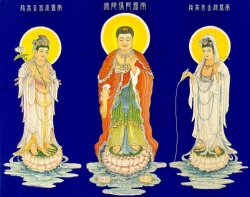Difference between revisions of "4 Seals"
(Created page with "thumb|250px| '''4 Seals''': All conditioned things are impermanent. All contaminated phenomena are suffering. All phenomena are empty and selfless. Ni...") |
|||
| (7 intermediate revisions by 3 users not shown) | |||
| Line 1: | Line 1: | ||
[[File:Medi837392.jpeg|thumb|250px|]] | [[File:Medi837392.jpeg|thumb|250px|]] | ||
| − | '''4 Seals''': All conditioned things are impermanent. All contaminated phenomena are suffering. All phenomena are empty and selfless. Nirvana is peace. | + | |
| + | |||
| + | |||
| + | |||
| + | |||
| + | |||
| + | |||
| + | '''[[4 Seals]]''': All [[conditioned things]] are {{Wiki|impermanent}}. All contaminated [[phenomena]] are [[suffering]]. All [[phenomena]] are [[empty]] and [[selfless]]. [[Nirvana]] is [[peace]]. | ||
| + | |||
| + | |||
| + | The [[Four Seals]] | ||
| + | |||
| + | |||
| + | [[File:Namo A.jpg|thumb|250px|]] | ||
| + | According to [[Buddhism]], a thorough [[understanding]] of the “[[Four Seals]]” can bring an end to [[suffering]]. Some [[Buddhist]] [[traditions]] mention only the first three together, referring to them as the “[[Three Marks of Existence]]” or “[[Three Signs of Being]].” Other [[traditions]] add [[the fourth]], to explain that the first three are not the be all and end all of things. | ||
| + | |||
| + | |||
| + | The first three apply without fail to everything in this [[world]], everything material, [[objective]], and [[conditioned]], and are thus a brief summary and diagnosis of the very [[nature]] of [[Samsara]]. The fourth points to [[Nirvana]]. | ||
| + | |||
| + | The late [[Venerable]] [[Lobsang Gyatso]] of the [[Gelugpa]] [[tradition]] of [[Tibetan Buddhism]] wrote that “All [[Buddhist]] teachings can be condensed into these four points,” adding that “These four points are seen as the [[root]] of [[Buddhism]].” | ||
| + | |||
| + | |||
| + | Alongside the [[Four Noble Truths]], the [[Noble Eightfold Path]], and the [[Twelve Nidanas]], the [[Four Seals]] provide the basic introduction to the [[Buddhist]] worldview. They are… | ||
| + | |||
| + | |||
| + | #1. All {{Wiki|conditioned}} [[phenomena]] are {{Wiki|impermanent}}. | ||
| + | |||
| + | #2. All {{Wiki|conditioned}} (and therefore contaminated) [[phenomena]] are in the [[nature]] of [[suffering]]. | ||
| + | |||
| + | |||
| + | #3. All [[phenomena]] are [[empty]] and [[selfless]]. | ||
| + | |||
| + | #4. [[Nirvana]] is [[peace]]. | ||
| + | |||
| + | In verses 277-279 of the [[Dhammapada]], the [[Buddha]] states: | ||
| + | |||
| + | |||
| + | “{{Wiki|Impermanent}} are all {{Wiki|conditioned}} things.” He who [[knows]] this ceases to be [[subject]] to [[grief]] and [[misery]]. This is the [[Path]] of {{Wiki|Purity}}. | ||
| + | |||
| + | “Full of [[pain]] are all {{Wiki|conditioned}} things.” He who [[knows]] this ceases to be [[subject]] to [[grief]] and [[misery]]. This is the [[Path]] of {{Wiki|Purity}}. | ||
| + | |||
| + | |||
| + | “Unsubstantial are all [[conditioned things]].” He who [[knows]] this ceases to be [[subject]] to [[grief]] and [[misery]]. This is the [[Path]] of {{Wiki|Purity}}. | ||
| + | |||
| + | |||
| + | “With the words ‘[[impermanent]],’ ‘[[suffering]],’ ‘[[selfless]],’ and ‘{{Wiki|peace}}’ the [[Buddhas]] who know all means persuade {{Wiki|sentient beings}} to generate weariness with the three [[realms]] of [[existence]] and to fully enter into the [[state]] beyond torment and [[pain]].” — [[Uttara Tantra]] ([[Ratnagotravibhaga]]) | ||
{{R}} | {{R}} | ||
[http://college.holycross.edu/projects/himalayan_cultures/2006_plans/hkaiter/Buddhism_by_Numbers.htm college.holycross.edu] | [http://college.holycross.edu/projects/himalayan_cultures/2006_plans/hkaiter/Buddhism_by_Numbers.htm college.holycross.edu] | ||
| + | |||
| + | [[Category:Buddha Seal's]]{{BuddhismbyNumber}} | ||
Latest revision as of 10:51, 20 November 2023
4 Seals: All conditioned things are impermanent. All contaminated phenomena are suffering. All phenomena are empty and selfless. Nirvana is peace.
The Four Seals
According to Buddhism, a thorough understanding of the “Four Seals” can bring an end to suffering. Some Buddhist traditions mention only the first three together, referring to them as the “Three Marks of Existence” or “Three Signs of Being.” Other traditions add the fourth, to explain that the first three are not the be all and end all of things.
The first three apply without fail to everything in this world, everything material, objective, and conditioned, and are thus a brief summary and diagnosis of the very nature of Samsara. The fourth points to Nirvana.
The late Venerable Lobsang Gyatso of the Gelugpa tradition of Tibetan Buddhism wrote that “All Buddhist teachings can be condensed into these four points,” adding that “These four points are seen as the root of Buddhism.”
Alongside the Four Noble Truths, the Noble Eightfold Path, and the Twelve Nidanas, the Four Seals provide the basic introduction to the Buddhist worldview. They are…
- 1. All conditioned phenomena are impermanent.
- 2. All conditioned (and therefore contaminated) phenomena are in the nature of suffering.
In verses 277-279 of the Dhammapada, the Buddha states:
“Impermanent are all conditioned things.” He who knows this ceases to be subject to grief and misery. This is the Path of Purity.
“Full of pain are all conditioned things.” He who knows this ceases to be subject to grief and misery. This is the Path of Purity.
“Unsubstantial are all conditioned things.” He who knows this ceases to be subject to grief and misery. This is the Path of Purity.
“With the words ‘impermanent,’ ‘suffering,’ ‘selfless,’ and ‘peace’ the Buddhas who know all means persuade sentient beings to generate weariness with the three realms of existence and to fully enter into the state beyond torment and pain.” — Uttara Tantra (Ratnagotravibhaga)

